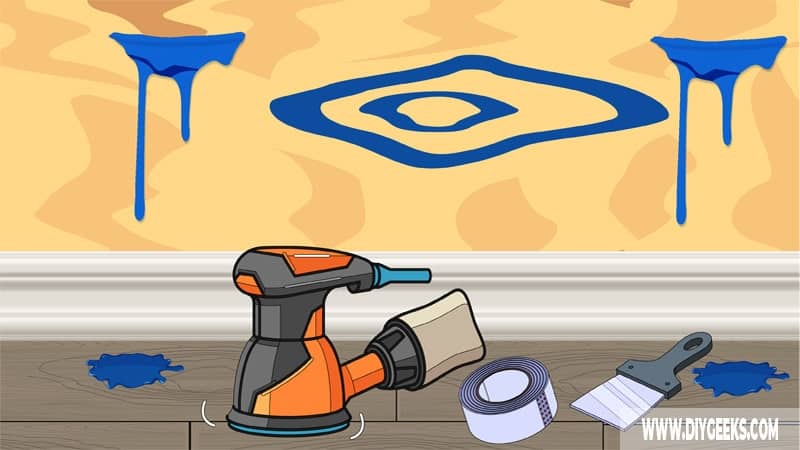Paint peels off from drywall wall surfaces because of improper surface prep, moisture exposure, and bad paint application.
You can’t paint over drywall peeling paint as the new paint won’t adhere properly and will peel off for the same reasons.
To fix peeling paint on drywall, remove the peeling paint, fix the drywall surface, sand the surface, apply primer, apply paint, and seal the finish.
Why Does Paint Peel Off From Drywall Surfaces?
Paint peels off from drywall surfaces for the following reasons.
- Improper Surface Prep.
- Moisture Exposure.
- Bad Paint Application.
- The Drywall is Sealed.
- You Mixed Two Different Paint Types.
1. Improper Surface Prep
Paint peels off from drywall surfaces if you don’t prep the surface properly. You must clean, sand, and prime the surface to remove surface imperfections, dust, and dirt that can prevent proper paint penetration or adhesion.
If you don’t prep the drywall surface properly, the paint won’t have good adhesion to the surface and will peel off.
2. Moisture Exposure
Unsealed paint peels off if the drywall surface is exposed to constant moisture, water, or rainfall. Drywall is a porous material that absorbs water which damages the paint adhesion if the surface isn’t properly sealed.
3. Bad Paint Application
Paint peels off from surfaces if you use the wrong applicator method, don’t allow enough paint dry time between coats, or apply too many coats.
4. Sealed Drywall
If the drywall surface is already sealed (or painted), a new paint won’t adhere properly over it and can peel off. A sealer produces a moisture-resistant layer (barrier) that prevents paint penetration or adhesion.
Ensure to remove existing finishes from drywall before applying a new one.
5. You Mixed Two Different Paint Types
If you mix two different paint types, such as water-based and oil-based, the mixture won’t adhere or dry properly and can peel off.
Can You Paint Directly Over Drywall Peeling Paint?
You can’t paint directly over drywall peeling paint as the new paint won’t adhere properly and will peel off. The same issues that made the existing finish peel off, will cause the new finish to peel off too.
For instance, if the existing paint finish is peeling off because of moisture exposure, the new finish will also peel off from it. It’s recommended to remove the existing finish, fix the surface issues, and re-apply the new paint.
How To Fix Peeling Paint On Drywall?
To fix peeling paint on drywall, do the following things.
- Remove the Peeling Paint Finish.
- Repair the Drywall Surface.
- Sand the Surface.
- Apply Primer.
- Apply Paint.
- Seal the Finish.
The tools you need for this project are listed below.
- A plastic putty knife
- Large nylon bags
- Medium and fine-grit sandpaper
- Brush or sprayer
- Polyurethane/Varnish
- Joint compound
- Rags
- Tape
- Paint stripper (Optional)
1. Remove the Peeling Paint Finish
Remove the peeling paint finish from the drywall using a paint-stripping paste. The paint-stripping paste penetrates the finish, dissolves the binder, and softens the coating.
To remove paint from drywall, do the following thing.
- Apply paint-stripping paste directly over the drywall.
- Wait around 20 minutes.
- Use a scraper or scrubbing brush to remove the soft paint.
- Re-apply the paint-stripping paste to the leftover paint.
- Use warm soapy water to remove the paint-stripping paste residue from the drywall.
- Allow the drywall to dry.
2. Repair the Drywall
Repair the drywall surface if it has holes, cracks, or splits as these imperfections can prevent a smooth finish.
To repair drywall surface imperfections, do the following things.
- Apply joint compound over the affected spots.
- Remove excess joint compound.
- Wait around 30 minutes.
- Sand the affected spot with extra fine-grit sandpaper (440-grit).
3. Sand the Drywall
Sand the drywall surface with fine-grit sandpaper (220-grit) to remove surface imperfections and bumps that can prevent good paint penetration or adhesion.
4. Apply Primer
Apply one (1) primer coating to cover the plywood surface pores and imperfections, and create a textured layer over the surface that the paint can penetrate and adhere to.
Drywall is a porous material and can absorb too much paint if you don’t apply a primer coating. The primer coating is thicker and seals the surface pores so they don’t absorb too much paint.
5. Apply Paint
Apply 2-3 paint coats over the drywall surface using a paint roller, brush, or sprayer. Wait until one coat dries before applying the next one.
Use water-based paint for indoor drywall surfaces and oil-based paint for outdoor surfaces.
6. Seal The Finish
Seal the paint finish and drywall with an exterior sealer. The sealer creates a moisture-resistant layer (barrier) over the paint and plywood and protects them from moisture, water, scratches, and weather elements.
For indoor surfaces, sealing is optional as they aren’t exposed to constant water or weather elements.
How To Prevent Paint From Peeling off Drywall?
To prevent paint from peeling off drywall, do the following things.
- Prep the surface properly.
- Use paint and primer made for drywall.
- Allow enough paint dry time between coats.
- Seal the finish with an exterior sealer.
- Don’t mix different paint types.
- Only apply paint when the temperature range is between 50°F-85°F (10°C-30°F) and the humidity levels are lower than 50%.


